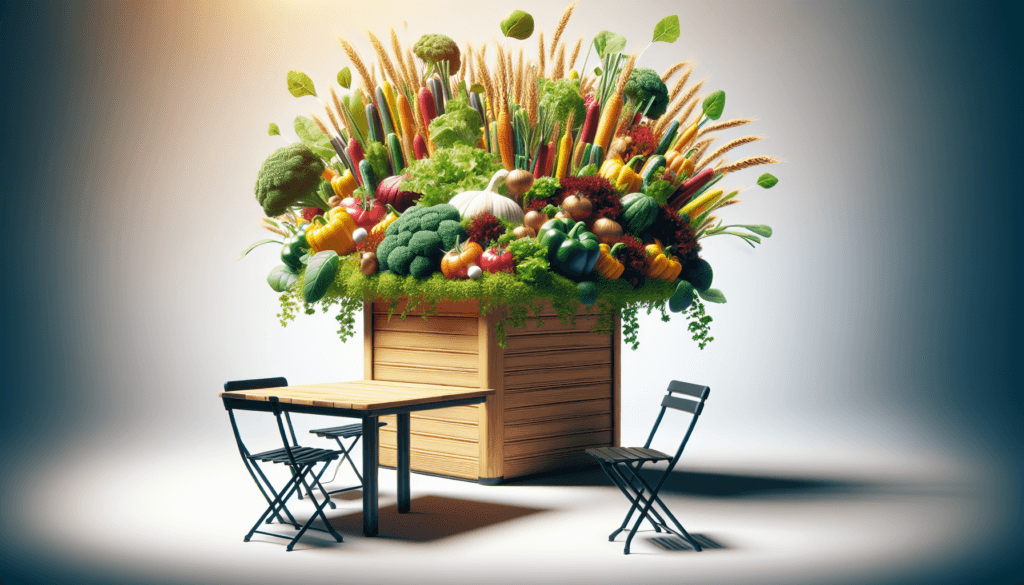In this article, you’ll explore a plethora of exciting container veggie gardening ideas that will ignite your green thumb. Discover how to transform even the smallest patch of land into a flourishing vegetable oasis. From choosing the perfect containers to selecting the right vegetables for your space, we’ve got you covered. Whether you’re a seasoned gardener looking for fresh inspiration or a beginner eager to embark on this green journey, these ideas will surely make your container veggie garden a sight to behold. So grab a cup of coffee, put on your gardening gloves, and let’s dive right into the world of container veggie gardening!

Choosing the Right Containers
When it comes to container gardening, choosing the right containers is crucial for the success of your vegetable garden. There are various types of containers available, each with its own benefits and drawbacks. Clay pots are a popular option as they are porous, allowing for better air circulation and water drainage. Plastic containers, on the other hand, are lightweight and more affordable. Another option is wooden containers, which can add a rustic touch to your garden but require extra maintenance.
In addition to considering the type of container, you also need to think about the size and depth. Vegetables like tomatoes and peppers have deep root systems, so you will need larger containers with a depth of at least 12 inches. Smaller plants like lettuce and herbs, on the other hand, can thrive in shallower containers. It’s important to choose containers that provide ample space for the roots to grow and allow for proper airflow.
When it comes to material options, you can choose between containers made of clay, plastic, or wood. Each material has its own advantages and disadvantages. Clay pots are aesthetically pleasing and provide good water drainage, but they can be heavy and prone to cracking. Plastic containers are lightweight and affordable but may not have the best airflow. Wooden containers are durable and lend a natural look to your garden, but they require regular maintenance to prevent rotting.
Selecting the Best Location
The success of your container vegetable garden depends on finding the right location. Most vegetables require at least six to eight hours of sunlight per day. When choosing a spot for your containers, consider areas that receive direct sunlight, such as balconies, patios, or rooftops. If your available space doesn’t get much sunlight, you can choose vegetables that tolerate partial shade, such as lettuce or spinach.
In addition to sunlight requirements, you also need to consider temperature and wind conditions. Some vegetables, like tomatoes and peppers, thrive in warm temperatures, while others, like lettuce, prefer cooler temperatures. Make sure to choose a location that provides the optimal temperature range for the vegetables you want to grow. Additionally, avoid areas that are prone to strong winds, as they can damage your plants and cause soil erosion.

Suitable Vegetables for Container Gardening
Container gardening is a versatile way to grow a variety of vegetables right at your doorstep. Certain vegetables are particularly well-suited for container gardening due to their compact growth habit and adaptability. Some popular vegetable choices for container gardening include tomatoes, peppers, lettuce, and herbs.
Tomatoes are one of the most popular choices for container gardening. There are many dwarf varieties available that are perfect for smaller containers. Cherry tomatoes, patio tomatoes, and determinate varieties are all great options. They provide a bountiful harvest and are relatively easy to care for.
Peppers, both sweet and hot varieties, also thrive in containers. They require full sun and well-draining soil. Compact varieties, such as bell peppers or jalapenos, are well-suited for container gardening. You can enjoy fresh peppers throughout the growing season by growing them in containers.
Lettuce and leafy greens are excellent choices for container gardening, especially for those with limited space. They have shallow roots and can tolerate partial shade. Leafy greens like spinach, kale, and arugula can be in proximity to each other and harvested as needed, providing a continuous supply of fresh greens.
Herbs are another great option for container gardening. They are compact, easy to care for, and can add flavor to your meals. Popular herbs like basil, parsley, rosemary, and mint can be grown in containers and harvested as needed throughout the growing season.
Preparing the Containers
Before you start planting, it’s important to prepare your containers properly to provide the best growing environment for your vegetables. Cleaning and disinfecting your containers is essential to prevent the spread of diseases and pests. Start by scrubbing off any dirt or debris from the containers using a brush. Then, soak the containers in a solution of one part bleach to nine parts water for about 10 minutes. Rinse thoroughly with clean water before using.
Proper drainage is crucial for container gardening. Without adequate drainage, excess water can accumulate and lead to root rot. To ensure proper drainage, drill or punch holes at the bottom of your containers. The size and number of drainage holes depend on the size of the container. As a general rule, larger containers require more drainage holes.
Choosing the right soil mix is essential for the success of your container garden. Regular garden soil is not suitable for container gardening as it tends to compact and inhibit root growth. Opt for a high-quality potting mix that is lightweight, well-draining, and high in organic matter. You can also enhance the soil mix by adding compost or other organic matter to provide nutrients for your plants.

Planting and Seeding Tips
When it comes to starting your container vegetable garden, you have two options: using transplants or seeds. Transplants are young plants that have already been grown from seeds. They save you time and guarantee a head start, especially for vegetables with a longer growing season. Seeds, on the other hand, give you more variety options and are more cost-effective.
When planting your vegetables, it’s important to consider the proper planting depths. As a general rule, plant transplants at the same depth they were growing in their original container. For seeds, follow the instructions on the seed packet as different vegetables have different planting depth requirements. Planting too shallow or too deep can affect the germination and growth of your vegetables.
Spacing guidelines are also important to prevent overcrowding and competition for nutrients. Give your plants enough space to grow by following the recommended spacing guidelines. This information can usually be found on the seed packet or plant tag. Giving your plants ample space allows for proper air circulation and reduces the risk of disease spread.
Providing Adequate Watering and Drainage
Watering is a critical aspect of maintaining a healthy container vegetable garden. Proper watering frequency and methods can make a significant difference in the growth and productivity of your plants. The frequency of watering depends on various factors, including the type of vegetable, weather conditions, and the size of the container.
Monitor the soil moisture regularly by sticking your finger about an inch deep into the soil. If it feels dry at that depth, it’s time to water. Be sure to water thoroughly until the excess water drains out from the drainage holes. Avoid watering too frequently, as it can lead to overwatering and root rot.
Preventing overwatering is crucial for the health of your plants. Make sure your containers have proper drainage holes and don’t allow excess water to accumulate in the saucers. If you notice waterlogged soil or wilting plants, adjust your watering habits accordingly. Remember that under-watering is often easier to correct than overwatering.

Feeding and Fertilizing Strategies
Proper feeding and fertilizing are essential for the overall health and productivity of your container vegetable garden. There are two main options when it comes to fertilizers: organic and synthetic. Organic fertilizers, such as compost or worm castings, are derived from natural sources and provide a slow-release of nutrients. Synthetic fertilizers, on the other hand, are chemically formulated and provide an immediate nutrient boost.
The frequency of feeding depends on the type of fertilizer used. Organic fertilizers often need to be reapplied every four to six weeks, while synthetic fertilizers can be applied every two to four weeks. Follow the instructions on the fertilizer packaging for the best results.
Recognizing nutrient deficiencies in your plants is crucial for timely intervention. Common signs of nutrient deficiencies include yellowing leaves, stunted growth, and poor fruit production. By observing your plants regularly and identifying any visual changes, you can take appropriate action to address the nutrient deficiencies. Soil testing kits are also available to help pinpoint specific nutrient imbalances.
Managing Pests and Diseases
One of the challenges of container gardening is dealing with pests and diseases. Identifying common pests is the first step towards managing them effectively. Common pests in vegetable gardens include aphids, caterpillars, slugs, and snails. Inspect your plants regularly and look for signs of pest damage, such as chewed leaves or sticky residue left by aphids.
Natural pest control methods can be employed to protect your container vegetables. This includes introducing beneficial insects like ladybugs or lacewings, planting companion plants that repel pests, or using homemade organic sprays like neem oil. Avoid using chemical pesticides, as they can harm beneficial insects and contaminate your vegetables.
Common diseases that can affect container vegetables include fungal infections, such as powdery mildew or leaf spot diseases. Prevention is key in managing diseases. Ensure proper air circulation around your containers, avoid overcrowding, and monitor the moisture levels to prevent fungal growth. Remove any infected plant parts promptly and consider using organic fungicides if necessary.
Maintaining and Pruning Container Vegetables
Maintaining your container vegetables is essential to ensure their healthy growth and productivity. Staking and support systems are often necessary for vining plants like tomatoes or peppers to prevent them from sprawling and breaking under their own weight. Use bamboo stakes, trellises, or cages to provide support as the plants grow.
Pinching and pruning techniques can also be employed to manage the size and shape of your plants. Pinching involves removing the growing tip of the plant to promote branching and a bushier growth habit. Pruning is done to remove any dead or diseased plant parts, as well as to improve airflow and light penetration in the container.
Regular maintenance tasks, such as removing weeds, checking for pests, and inspecting for diseases, should be done on a routine basis. This helps to keep your container garden tidy and prevents any potential issues from escalating. Additionally, removing spent flowers or fruits encourages continued production and prevents the plants from focusing their energy on producing seeds.
Harvesting and Storage Tips
The reward of container gardening is enjoying fresh, homegrown vegetables right from your own patio. Determining the right time to harvest your vegetables is crucial for optimal flavor and texture. Each vegetable has its own indicators of ripeness, such as color, size, or texture. Refer to gardening references or seed packets for specific harvest guidelines.
Proper storage is important to prolong the shelf life of your harvested vegetables. For most vegetables, storing them in a cool, dry place is ideal. Some vegetables, like tomatoes, are best stored at room temperature to preserve flavor. Others, like greens or herbs, can be stored in the refrigerator in a plastic bag with a damp paper towel to maintain freshness.
If your garden produces an abundance of vegetables, preserving excess produce is a great way to enjoy them throughout the year. There are various methods of preservation, including canning, freezing, or drying. Pickling is also a popular option for vegetables like cucumbers or peppers. Refer to reliable preserving resources for detailed instructions on each method.
In conclusion, container gardening offers a convenient and accessible way to grow your own vegetables. By choosing the right containers, providing the best location, selecting suitable vegetables, preparing the containers properly, implementing proper planting and watering techniques, fertilizing and preventing nutrient deficiencies, managing pests and diseases, maintaining and pruning your plants, and harvesting and storing your produce correctly, you can create a successful and rewarding container vegetable garden right at your own doorstep. Happy gardening!


